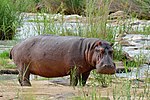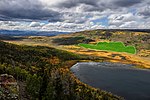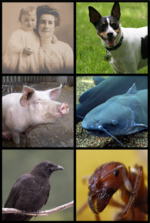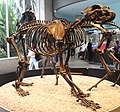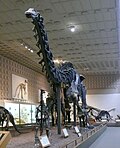Browsing is a type of herbivory in which a herbivore (or, more narrowly defined, a folivore) feeds on leaves, soft shoots, or fruits of high-growing,...
19 KB (2,204 words) - 06:48, 22 April 2024
Browsing is a kind of orienting strategy. It is supposed to identify something of relevance for the browsing organism. In context of humans, it is a metaphor...
8 KB (937 words) - 20:21, 28 April 2024
resources Browsing, a kind of orienting strategy in animals and human beings Browsing (herbivory), a type of feeding behavior in herbivores Browse Island...
911 bytes (153 words) - 14:23, 2 January 2023
Megaherbivore (section Browsers and grazers)
rhinoceroses exhibit both grazing and browsing feeding habits. The hippopotamus and white rhinoceros prefer grazing herbivory, while giraffes and the three other...
46 KB (4,375 words) - 19:07, 24 August 2024
Plant defense against herbivory or host-plant resistance (HPR) is a range of adaptations evolved by plants which improve their survival and reproduction...
97 KB (11,269 words) - 03:26, 9 August 2024
able to add financial compensation as a further source of income. Browsing (herbivory) Dehesa Field Meadow Transhumance Environmental impact of cattle...
14 KB (1,686 words) - 21:30, 12 August 2024
assessment of Pando's status in 2018 and stressed the importance of reducing herbivory by mule deer as critical to conserving Pando for the future. In 2019,...
32 KB (3,576 words) - 23:33, 26 August 2024
because toxins in the bark, twigs, and leaves of pawpaw repel herbivory, forests browsed by overpopulated deer offer pawpaw even more competitive advantages...
86 KB (8,910 words) - 02:56, 28 August 2024
Savanna (section Grazing and browsing animals)
Vavra, Laycock and Pieper (eds.) Ecological Implications of Livestock Herbivory in the West. Society For Range Management, Denver ISBN 1-884930-00-X....
41 KB (4,837 words) - 19:07, 24 August 2024
scavenging on dead prey, though many predators also scavenge; it overlaps with herbivory, as seed predators and destructive frugivores are predators. Predators...
109 KB (11,576 words) - 06:25, 19 August 2024
colleagues stated therizinosaurs were the most-widely regarded candidates for herbivory among theropods based on the small, densely packed, coarse serrations;...
29 KB (3,311 words) - 04:29, 21 June 2024
accepted to fall within the spectrum of omnivory and herbivory, with a trend towards intensified herbivory. While various anatomical features have been used...
82 KB (9,896 words) - 22:58, 10 July 2024
increased herbivory on the native vegetation of the ecosystem, which can make it harder for other herbivores to find food. The increased herbivory can also...
34 KB (3,630 words) - 07:29, 20 August 2024
leaves that contain tannins, which are thought to serve as deterrents to herbivory. Like all African acacias, they are defended by spines. In addition, whistling...
12 KB (1,318 words) - 22:56, 8 May 2024
development. In particular, JAs are critical for plant defense against herbivory and plant responses to poor environmental conditions and other kinds of...
23 KB (2,887 words) - 22:51, 13 June 2024
researchers argue that evolution of any species from herbivory to carnivory or carnivory to herbivory would be rare except via an intermediate stage of omnivory...
28 KB (2,826 words) - 19:51, 24 August 2024
berries, dispersing the seeds, and browsing the foliage; the presence of L. maackii may prevent deer from browsing understory vegetation, which can be...
18 KB (1,804 words) - 16:54, 8 June 2024
same time, increases in browse-tolerant grasses and sedges and unpalatable ferns have often accompanied intensive deer herbivory. Changes to the structure...
100 KB (11,583 words) - 17:00, 21 August 2024
extinction at the end of the Cretaceous. Sauropodomorphs were adapted to browsing higher than any other contemporary herbivore, giving them access to high...
28 KB (2,472 words) - 23:32, 27 July 2024
as they are considered to be the best regarded theropod candidates for herbivory. While other theropod groups are fully carnivorous, members of Therizinosauridae...
80 KB (9,266 words) - 16:05, 24 April 2024
and no native browsing animals were known. However, it is now believed that the spines were a defense against the moa-nalo, giant browsing geese and goose-like...
28 KB (2,670 words) - 22:37, 3 July 2024
of oaks. Oaks are also under threat from pests, pathogens, and animal browsing, all of which damage the vulnerable understory trees that replace older...
12 KB (1,471 words) - 02:15, 1 August 2024
in time, the more terrestrially adapted reptiles and synapsids evolved herbivory. Almost all predatory fishes (most sharks, tuna, billfishes, pikes etc...
9 KB (1,011 words) - 19:15, 23 May 2024
1023/A:1008980120379. S2CID 1480328. Landman, M. "Relevance of elephant herbivory as a threat to Important Plants in the Addo Elephant National Park, South...
10 KB (992 words) - 06:54, 8 August 2024
leaving, on occasion, more than 30 droppings and conspicuous evidence of herbivory. These areas, which are mostly dominated by mānuka and yellow silver pine...
99 KB (11,164 words) - 02:15, 13 August 2024
exploring two new food types, other tetrapods (carnivory), and later, plants (herbivory). Carnivory was a natural transition from insectivory for medium and large...
9 KB (902 words) - 14:48, 6 July 2024
Herbert H. T. (eds.), "The Ecology of Browsing and Grazing in Other Vertebrate Taxa", The Ecology of Browsing and Grazing II, Ecological Studies, vol...
95 KB (10,281 words) - 02:49, 27 August 2024




